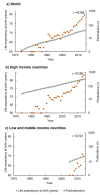Mapping the global research landscape and knowledge gaps on multimorbidity: a bibliometric study
- PMID: 28685036
- PMCID: PMC5475311
- DOI: 10.7189/jogh.07.010414
Mapping the global research landscape and knowledge gaps on multimorbidity: a bibliometric study
Abstract
Background: To summarize global research trends and activities on multimorbidity; then to assess the knowledge gaps and to identify implications for knowledge exchange between high income countries (HICs) and low- and middle- income countries (LMICs).
Methods: A comprehensive search was conducted to identify research publications on multimorbidity in the Web of ScienceTM, as well as diabetes, depression, hypertension, and Chronic Obstructive Pulmonary Disease (COPD). The time frame for the search was from 1900 to June, 2016. Information (such as publication date, subject category, author, country of origin, title, abstract, and keywords) were extracted and the full texts were obtained for the co-citation analysis. Data were linked with the life expectancy at birth (years) and Gross National Income (GNI). Co-citation and hierarchal clustering analysis was used to map the trends and research networks with CiteSpace II (JAVA freeware, copyright Chaomei Chen, http://cluster.cis.drexel.edu/~cchen/citespace/).
Findings: We identified 2864 relevant publications as at June 2016, with the first paper on this topic indexed in 1974 from Germany, but 80% were published after 2010. Further analysis yielded two knowledge gaps: (1) compared with single conditions (diabetes, hypertension, depression, and COPD), there is a mismatch between the high prevalence of multimorbidity and its research outputs (ratio of articles on multimorbidity vs other four single conditions is 1:13-150); (2) although a total of 76 countries have contributed to this research area, only 5% of research originated from LMICs where 73% of non-communicable disease (NCD) related deaths had occurred. Additional analysis showed the median year of first publication occurred 15 years later in the LMICs compared with HICs (2010 vs 1995); and longer life expectancy was associated with exponentially higher publication outputs (Pearson correlation coefficient r = 0.95) at the global level. The life expectancy at the median year (1994) of first publication was 66.1, with the gap between LMICs and HICs 7.9 (68.4 vs 76.3).
Conclusions: This study confirms substantial knowledge gaps in the research agenda on multimorbidity, with input urgently needed to move us forward worldwide, especially for and in LMICs. There is the possibility that LMICs can learn from and collaborate with HICs in this area.
Conflict of interest statement
Competing interests: All authors have completed the Unified Competing Interest form at www.icmje.org/coi_disclosure.pdf (available on request from corresponding author), and declare no conflicts of interest.
Figures





References
-
- World Health Organization. Global status report on noncommunicable diseases 2014. 2015. Available: http://www.who.int/nmh/publications/ncd-status-report-2014/en/. Accessed: 7 July 2016.
-
- World Health Organization. World Health Report on ageing and health. Available: http://apps.who.int/iris/bitstream/10665/186463/1/9789240694811_eng.pdf. Accessed: 7 July 2016.
-
- Mercer S, Salisbury C, Fortin M. ABC of multimorbidity. Hoboken; John Wiley & Sons; 2014.
MeSH terms
LinkOut - more resources
Full Text Sources
Other Literature Sources
Miscellaneous
